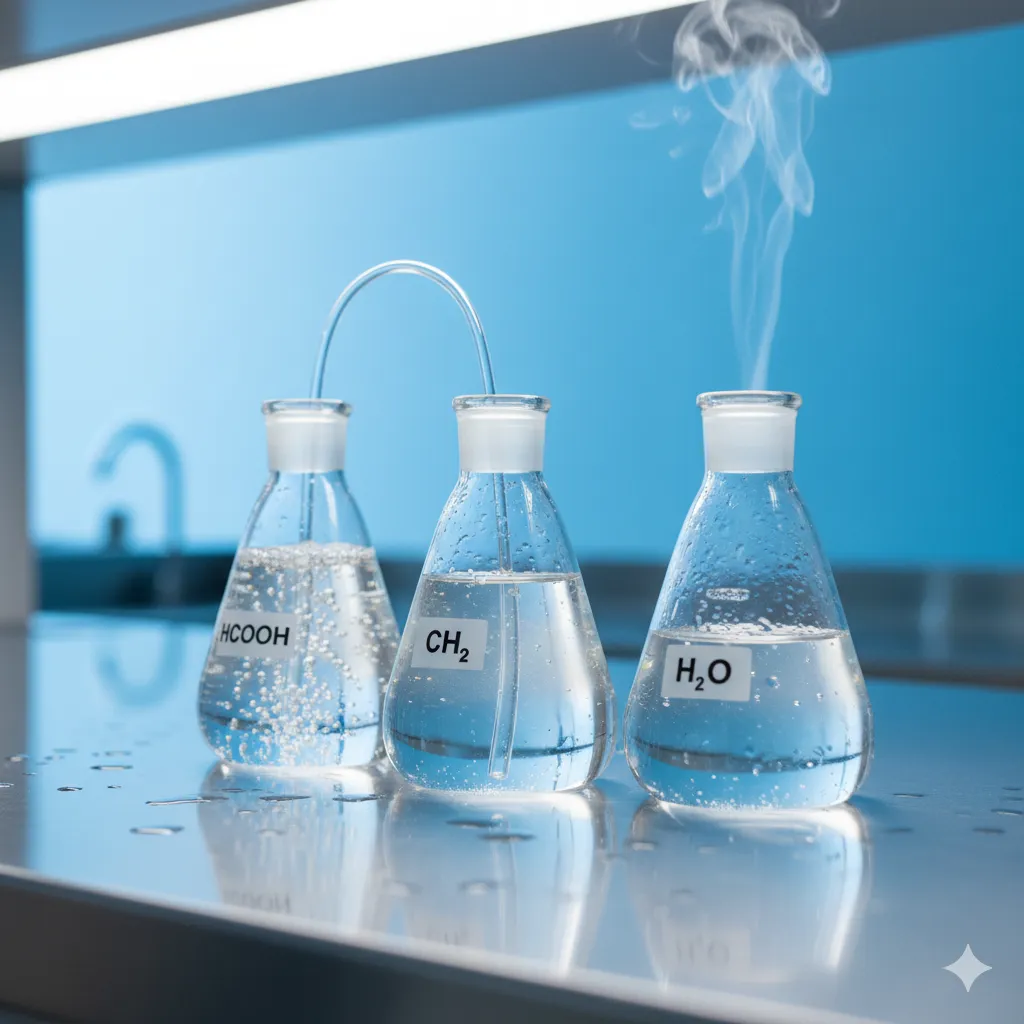HCOOH CH₂ H₂O Explained: Structure, Properties, and Industrial Applications

HCOOH CH₂ H₂O: Structure, Properties, and Key Uses
HCOOH CH₂ H₂O isn’t a single molecule but rather a system of three different chemical components that often appear together in laboratories and industries.
Each part serves a specific purpose:
- HCOOH → Formic acid, the simplest carboxylic acid
- CH₂ → Methylene group, a reactive carbon unit
- H₂O → Water, the universal solvent and reaction medium
Together, they participate in reactions involving acid-base chemistry, esterification, hydrolysis, polymer formation, and even hydrogen production — making this trio vital in both academic and industrial chemistry.
⚗️ Breaking Down the Components
1. Formic Acid (HCOOH): The Simplest Carboxylic Acid
Formic acid is a colorless liquid with a sharp, pungent odor.
It occurs naturally in ants, bees, and stinging nettles, and industrially it’s produced by hydrolyzing methyl formate or reacting carbon monoxide with water over a catalyst.
Key Properties
- Molecular weight: 46.03 g/mol
- Boiling point: 100.8 °C
- Forms an azeotrope with water at 77.5% concentration (bp = 107.3 °C)
Common Uses
- Leather tanning and textile finishing
- Rubber coagulation and dye fixation
- Feed preservation and antibacterial treatment
Its strong acidity and reducing ability make it a versatile reagent in chemical synthesis and industrial applications.
2. Methylene (CH₂): The Carbon Connector
The CH₂ unit is the simplest carbon-hydrogen fragment and rarely exists freely under normal conditions.
It usually appears as part of a larger organic structure — such as methanol, formaldehyde, or polymer chains.
In polymer chemistry, methylene groups link monomers, defining flexibility, melting point, and reactivity.
In advanced reactions, methylene carbene ( :CH₂ ) acts as a short-lived, highly reactive species that adds to double bonds or initiates polymerization.
3. Water (H₂O): The Universal Solvent
Water plays multiple roles in HCOOH CH₂ H₂O systems:
- Solvent: Dissolves reactants for faster molecular interaction
- Reactant: Participates in hydrolysis and hydration
- Product: Forms in esterification and condensation reactions
Its polarity and hydrogen-bonding capacity make it essential in maintaining equilibrium during acid-base or organic transformations.
🔬 Chemical Significance of HCOOH CH₂ H₂O Systems
When formic acid, methylene compounds, and water coexist, several important reactions can occur:
| Reaction Type | Description | Example |
|---|---|---|
| Hydrolysis | Breaks esters or amides using water | HCOOCH₃ + H₂O → HCOOH + CH₃OH |
| Esterification | Acid + alcohol → ester + water | HCOOH + CH₃OH ⇌ HCOOCH₃ + H₂O |
| Redox Process | Formic acid acts as reducing agent | HCOOH → CO₂ + H₂ |
| Polymerization | CH₂ units build molecular chains | Polyethylene formation |
These combined interactions show why this mixture is often found in synthetic chemistry, materials science, and renewable-energy research.
🏭 Industrial and Laboratory Applications
Formic Acid in Manufacturing
- Leather & Textile Industries: Controls pH and fixes dyes
- Rubber Processing: Coagulates natural latex
- Feed Preservation: Inhibits bacterial growth
Water dilutes the acid, while methylene-based compounds serve as reaction partners or solvents.
Synthesis of Methyl Formate
A classic esterification between formic acid and methanol:
[
\text{HCOOH + CH₃OH ⇌ HCOOCH₃ + H₂O}
]
This reversible reaction forms methyl formate, widely used as an intermediate in chemical manufacturing.
Fuel Cell and Hydrogen Storage
Formic acid can act as a liquid hydrogen carrier through the decomposition:
[
\text{HCOOH → H₂ + CO₂}
]
Catalyst systems containing CH₂-based structures enhance the reaction rate, offering a clean-energy route for hydrogen production under mild conditions.
🧪 Key Reactions Involving HCOOH CH₂ H₂O
- Esterification:
Formic acid + methanol → methyl formate + water - Hydrolysis:
Methyl formate + water → formic acid + methanol - Formaldehyde Formation:
Under catalytic conditions, formic acid with CH₂ sources yields CH₂O (formaldehyde) — critical in resin and polymer industries.
🌍 Environmental and Safety Considerations
Handling Formic Acid
- Corrosive; can cause skin burns or respiratory irritation
- Use acid-resistant gloves, goggles, and fume hoods
- Store in corrosion-proof containers
Waste Management
Industrial reactions may emit VOCs or CO₂.
Neutralize waste before disposal and comply with environmental safety regulations to minimize pollution.
🧫 Role in Analytical Chemistry
- Chromatography: Formic acid–water mixtures help regulate pH and improve separation efficiency.
- Spectroscopy: These components influence IR peaks, NMR shifts, and UV–Vis absorption, allowing chemists to monitor reaction progress and molecular interactions.
🔬 Future Research and Green Innovations
| Focus Area | Goal |
|---|---|
| Green Chemistry | Produce formic acid and methanol from renewable biomass |
| Catalyst Design | Create efficient, recyclable catalysts for cleaner reactions |
| Energy Storage | Optimize HCOOH–H₂O systems for portable fuel cells |
Such advances could make HCOOH CH₂ H₂O chemistry a foundation for sustainable, low-carbon technologies.
🧭 Conclusion
The trio of formic acid (HCOOH), methylene (CH₂), and water (H₂O) represents far more than basic chemical formulas — it’s a gateway to countless industrial, environmental, and research applications.
From fuel-cell hydrogen generation to polymer chemistry, these interactions power the processes that drive innovation. Understanding how each component behaves allows scientists and engineers to create cleaner, safer, and more efficient chemical systems for the future.
❓ Frequently Asked Questions (FAQs)
What is HCOOH CH₂ H₂O?
A shorthand for three components — formic acid, methylene, and water — that often participate together in chemical reactions.
Is HCOOH CH₂ H₂O one compound?
No. It refers to a mixture or reaction system, not a single molecule.
Where is this system used?
In leather tanning, textile processing, rubber manufacturing, methyl formate synthesis, and hydrogen-generation research.
What is the main industrial reaction?
Hydrolysis of methyl formate:
HCOOCH₃ + H₂O → HCOOH + CH₃OH.
Is formic acid safe?
Handle with caution — it’s corrosive. Use gloves, goggles, and proper ventilation.





